Filipino beef caldereta is more than just another beef stew. It’s a dish that tells a story with every bite, capturing the essence of Filipino home cooking—warm, hearty, rich, and made with love. If you’ve never tried it, think tender chunks of beef slow-simmered in a tomato-based sauce, made savory with liver spread and spiced just right. It’s a favorite for a reason and a must-try if you’re diving into Filipino cuisine.
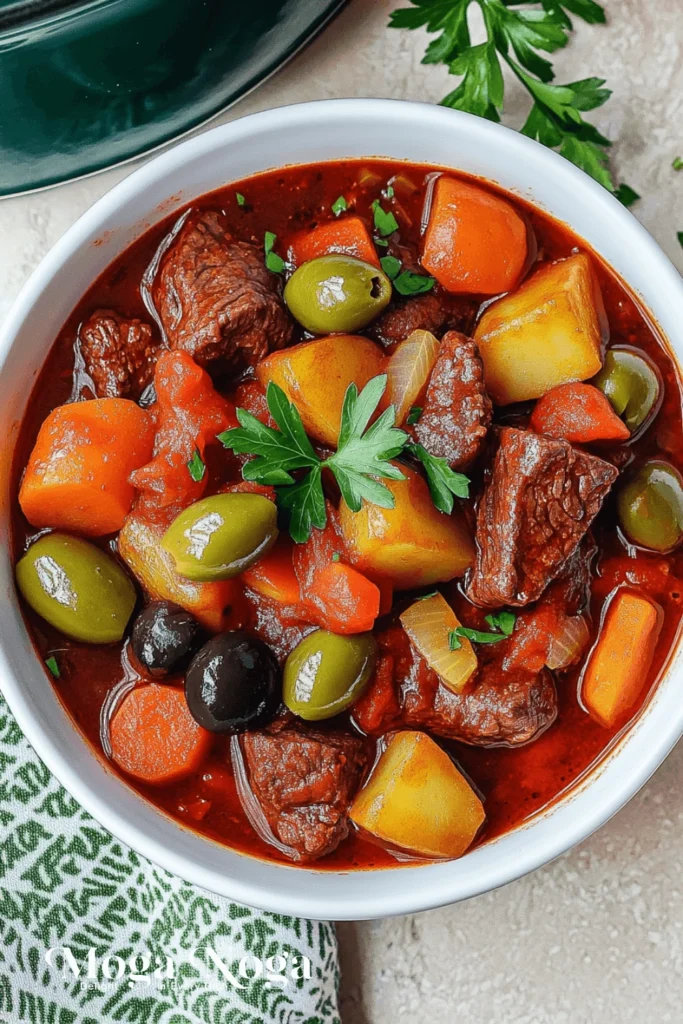
This dish stands out because of its depth of flavor and the way it brings together various culinary influences. While it shares similarities with Spanish-style stews, the Filipino take is distinct—thanks to regional touches and ingredients like patis, bay leaves, and sometimes even cheese. Whether served at a fiesta or a casual Sunday lunch, this stew delivers a soul-satisfying experience.
And here’s the best part: it’s a forgiving dish. You can tweak it based on what you have, make it as spicy or mild as you like, and even use different proteins. But no matter how you spin it, Filipino beef caldereta always hits the mark.
Table of Contents
Why You’ll Love This Recipe
This dish has all the comforting qualities you’d expect from a slow-cooked beef stew, but it brings a few extra layers that make it really shine. First, the beef is braised until fork-tender. No dry or stringy meat here—just melt-in-your-mouth bites. The sauce is the real star, though. It’s tomatoey but balanced with salty, umami notes from liver spread or pâté. You’ll also get occasional hints of sweetness from bell peppers and carrots, plus a little kick from chili if you like it spicy.
This Filipino beef caldereta recipe is a crowd-pleaser. It’s bold enough to stand out on its own but plays nicely with rice, bread, or even pasta. You can serve it at a holiday gathering, a family get-together, or just a regular weeknight when you need something solid and satisfying. Plus, it tastes even better the next day, making it a great make-ahead option.
And if you’re new to Filipino food, this is a great starting point. It’s familiar in format but packed with flavors you might not expect—from the liver spread to the spicy undertones. It’s classic and surprising all at once.
Detailed Ingredients and Instructions
Let’s break this dish down so it’s easy to tackle, even if you’re cooking it for the first time. While there are many versions, this guide sticks to a traditional approach with a few practical tips along the way.
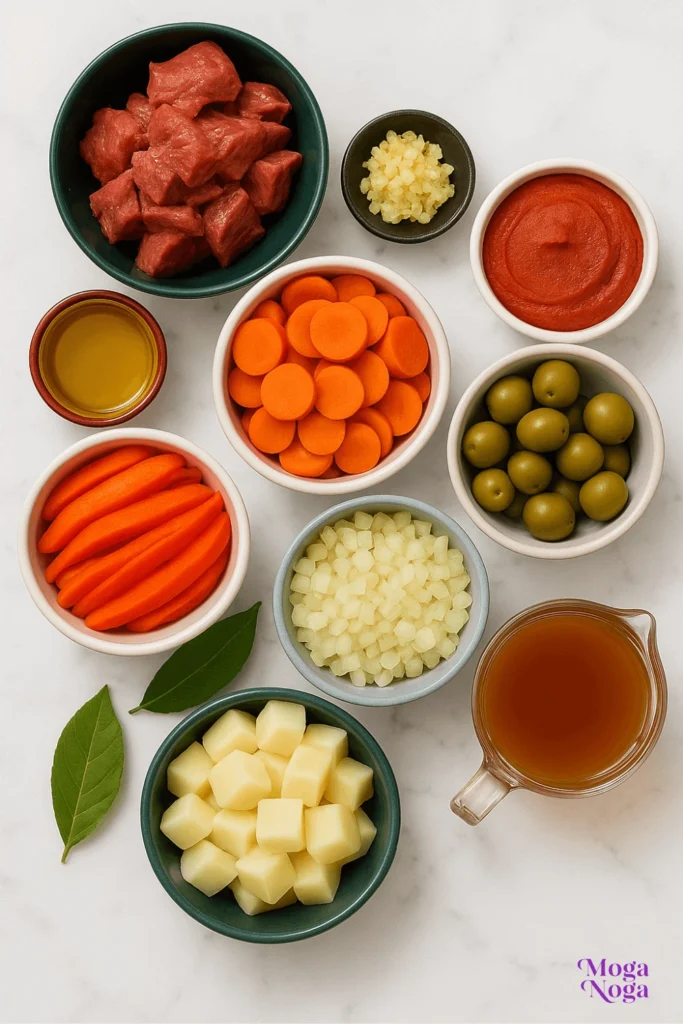
Start with a good cut of beef. Most people go for chuck or brisket—something with a bit of fat and connective tissue that breaks down during slow cooking. You want those gelatin-rich cuts that become buttery soft with time.
Sear the beef well. This is a small but crucial step. Browning the meat adds a ton of flavor and sets the base for a rich sauce. Don’t rush this. Do it in batches if needed to avoid overcrowding the pan.
The sofrito, or base of the sauce, usually includes garlic, onion, and tomato. Some cooks add tomato paste to intensify the flavor. Once the aromatics are soft and fragrant, you deglaze the pan with a bit of broth or water, scraping up all that good stuff from the bottom.
Now, here comes the unique part—add liver spread or canned liver pâté. This ingredient gives the dish its iconic richness. It blends right into the sauce and deepens the flavor. If you’re wary of it, try adding just a bit at first—you’ll be surprised how well it works.
Vegetables go in next. Potatoes, carrots, and bell peppers are the most common. Some versions also include green peas or even olives. Make sure to add the veggies in stages so they don’t turn to mush. Potatoes and carrots go in early, while bell peppers are better added closer to the end to keep their texture.
Simmer everything low and slow. The longer it cooks, the better it gets. Stir occasionally and add water or broth as needed. The sauce should be thick but not dry.
Finish with cheese if you want that creamy, extra-savory touch. Some people skip this, but a small handful of shredded cheese—especially something like cheddar—melts into the sauce and rounds it out beautifully.
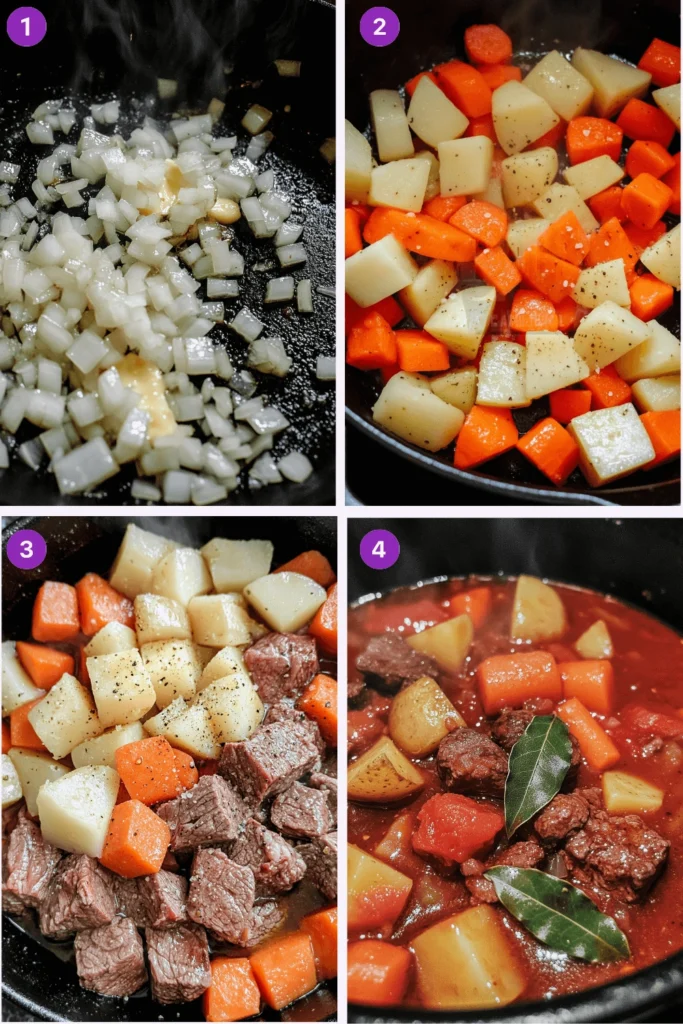
Tips, Variations, and Storage Options
If you’re cooking Filipino beef caldereta for the first time or looking to level up your usual version, here are some practical tips that can help you get the most out of the recipe.
For starters, don’t rush the beef. Slow cooking is the heart of this dish. Give the meat enough time to break down and become tender. You can do this on the stove, in a slow cooker, or even in a pressure cooker if you’re short on time. Just remember, flavor builds with time.
As for variations, there’s plenty of room to play. Some people add coconut milk for a creamier version. Others use peanut butter to give it a slight kare-kare twist. If you want a spicier caldereta, add more red chilies or a spoonful of chili oil at the end. Want it smoky? Try roasted bell peppers or even a touch of smoked paprika.
Not a fan of liver spread? You can swap it out with mashed anchovies or even miso paste for a different kind of umami. It’s not traditional, but it works well if you’re customizing it to fit your dietary preferences.
You can also switch up the protein. Pork caldereta is popular in some parts of the Philippines, and chicken works too—just reduce the cooking time. For a pescatarian version, use tuna or bangus and go lighter on the sauce.
As for storage, the Filipino beef caldereta is kept really well. In fact, many say it tastes better the next day as the flavors have more time to meld. Let it cool completely before storing. In the fridge, it will last up to five days. In the freezer, it’s good for a couple of months. When reheating, just add a splash of water or broth to loosen the sauce.
Equipment Needed
You don’t need a fancy kitchen to make a great caldera. Here are the basics you’ll need:
A heavy-bottomed pot or Dutch oven: This ensures even cooking and helps prevent the sauce from burning as it simmers.
A sharp chef’s knife — For cutting the beef and chopping vegetables.
A cutting board — Preferably one large enough to handle prep efficiently.
Measuring cups and spoons — To keep your ratios consistent.
A wooden spoon or spatula: This is used to stir the pot and scrape up browned bits after searing the meat.
Optional: A slow cooker or pressure cooker can be helpful if you’re adjusting the cooking method, especially if you’re cooking in bulk or short on time.
Related Recipes
If you love Filipino beef caldereta, here are a few other recipes that carry similar comfort and bold flavor profiles:
- Kare-Kare — A rich peanut stew made with oxtail and vegetables, served with bagoong. It’s creamy, savory, and equally festive.
- Beef Caldereta — A hearty tomato-based stew made with tender beef, vegetables, and liver spread. It’s rich, savory, and deeply comforting, with just the right balance of spice and sweetness.
- Afritada — Tomato-based like caldereta but lighter, often made with chicken or pork and without liver spread.
- Mechado — Another beef stew with soy sauce, vinegar, and tomatoes. The meat is sometimes larded with fat for extra richness.
- Menudo — A mix of pork, liver, and hotdogs in a tomato sauce, usually cut smaller and served with rice. It’s sweet, savory, and a staple in Filipino homes.
- Pochero — A Spanish-inspired stew that uses banana, chickpeas, and tomato broth, giving it a sweet-savory balance unlike any other.
Each of these dishes shares some DNA with caldereta but brings its own personality to the table.

Pairing/Serving Suggestions
Filipino beef caldereta is best served with a big scoop of steamed white rice. That’s the classic and most popular pairing—simple, absorbent, and it lets the flavors of the stew shine. You can also go with garlic fried rice if you’re aiming for something a bit more indulgent.
If you’re looking to pair it with drinks, go for something light and crisp to cut through the richness. A cold lager, dry white wine, or even calamansi juice works well.
As for sides, a simple cucumber salad or pickled vegetables like atchara adds a refreshing contrast. You can also serve pandesal or crusty bread to mop up the sauce.
For dessert, halo-halo or leche flan offers a sweet finish without overpowering the meal. You could also try turon for something with a little crunch.
When serving Filipino beef caldereta at gatherings, consider offering it buffet-style with rice and multiple sides. It holds well in a chafing dish and remains flavorful even after sitting out for a bit.
Frequently Asked Questions
What’s the best cut of beef for Filipino beef caldereta
Use beef chuck or brisket. These cuts have just the right amount of fat and connective tissue that melts down during slow cooking, giving you a soft, juicy texture without falling apart. Avoid lean cuts—they can dry out and become chewy.
Is liver spread necessary
It’s a key ingredient in traditional caldereta, lending depth and umami to the sauce. If you’re hesitant, start with a small amount and build up from there. You can also try substitutions like mashed anchovies, pâté, or even a bit of miso if you’re avoiding organ meats.
Can I make this dish ahead of time?
Yes, and it actually tastes better the next day. The flavors deepen overnight, so it’s perfect for batch cooking or prepping for events. Store it in the fridge and gently reheat it on the stove or in a microwave with a little added water or broth.
Can I make this in a pressure cooker or Instant Pot
Absolutely. Just sear the beef using the sauté function, then add the ingredients and cook on high pressure for about 35 minutes. Use natural release and finish off by simmering with the veggies until they’re tender.
Is it possible to make a spicy version?
Yes! You can control the heat level easily. Add fresh chili peppers, chili flakes, or a spoon of chili garlic sauce to dial up the spice. Siling labuyo is the go-to for authentic Filipino heat.
Nutrition Information
The values here are based on an average serving size of Filipino beef caldereta made with beef chuck, vegetables, and standard ingredients without added cheese.
Calories: Roughly 390 per serving
Protein: Around 25 grams
Carbohydrates: About 14 grams
Fats: Approximately 26 grams
Sodium: Will vary depending on the use of liver spread and broth
Note that these values will shift depending on portion size, beef cut, added fat, or if you choose to include optional ingredients like cheese or coconut milk.
Seasonal and Occasion Variations
Filipino beef caldereta can easily be adapted to different seasons and special events. In the summer, go lighter with the sauce and add more bell peppers for a fresh feel. You can even grill the beef before stewing to give it a smoky barbecue twist.
During cooler months, add more hearty vegetables like sweet potatoes or squash. These thicken the sauce naturally and give it a cozy autumn feel.
For holidays like Christmas and New Year, dress it up by using premium beef cuts, adding cheese, olives, or even a dash of red wine for a richer version. Serve it in a big ceramic pot and garnish with fresh parsley or bell pepper strips for a festive look.
During Holy Week or for pescatarian guests, switch the protein to fish or seafood. The tomato-based sauce pairs well with tuna, milkfish, or even shrimp. It’s a bit untraditional but works beautifully.
At birthdays or fiestas, Filipino beef caldereta is often served alongside other saucy dishes. To help it stand out, make it spicy, top it with shredded cheese, and serve it with fresh pan de sal.
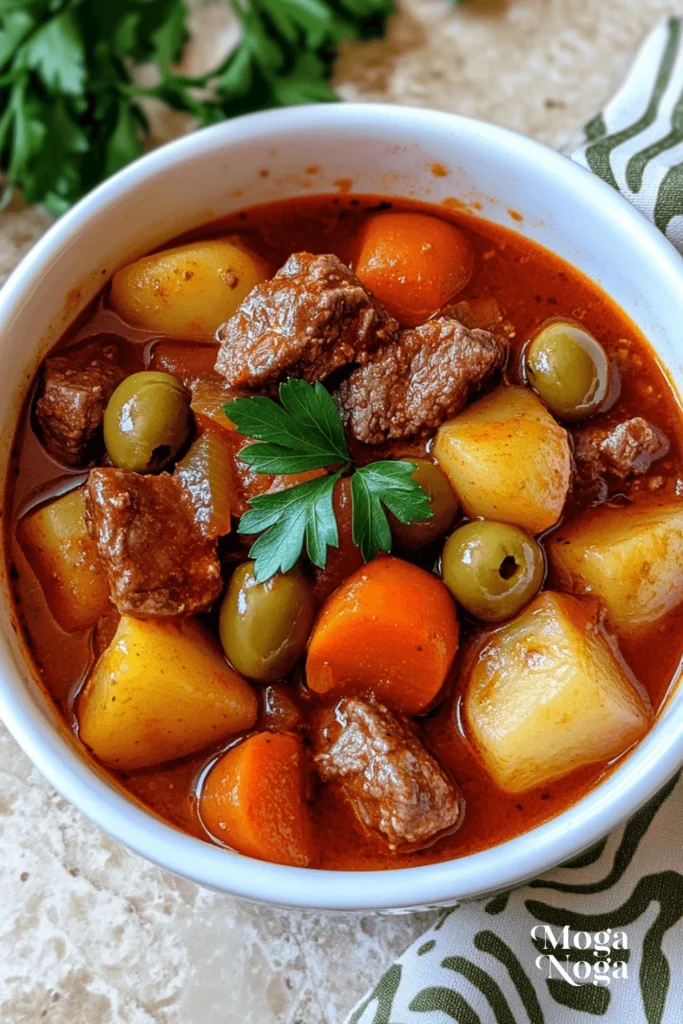
My Recipe Tips
Here are some practical, tried-and-tested tips to help you avoid common pitfalls and bring your best version of Filipino beef caldereta to the table:
Brown your meat properly. This isn’t a step to skip or rush. A well-seared crust locks in flavor and makes your sauce taste like it simmered all day.
Don’t drown it in liquid. Start with just enough broth or water to cover the beef. You can always add more as it cooks. Too much liquid and your caldereta turns into a soup.
Use fresh aromatics. Garlic and onions set the foundation. Don’t rely on powder substitutes here if you can avoid it—they make a big difference in the overall flavor.
Watch the salt. Liver spread, cheese, and broth can all be salty. Taste as you go to avoid ending up with an overly salted stew.
Stir occasionally. This helps prevent burning and ensures even cooking, especially once the sauce starts thickening.
Add the cheese last. If you’re using it, don’t add it too early. Let the stew cook down first, then stir in the cheese toward the end so it melts smoothly and doesn’t curdle.
Conclusion
Filipino beef caldereta is one of those dishes that doesn’t just fill your belly—it feeds your soul. Whether you’re cooking it to impress guests, bring comfort to your family table, or try something new in the kitchen, this dish delivers every time. Rich, tender, flavorful, and flexible, it’s an absolute keeper in any recipe collection.
And once you’ve nailed your favorite version, it becomes something you pass on. It’s one of those meals that sticks in memory, one plate at a time.
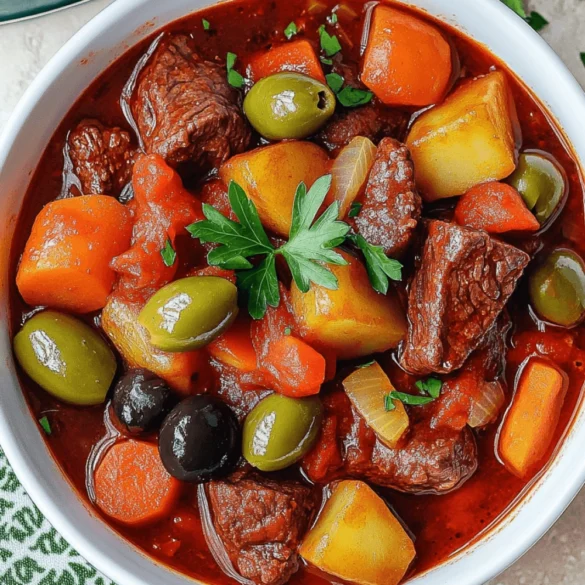
🐮 Filipino Beef Caldereta 🍅🥔
Ingredients
2 lbs beef chuck or stew meat, cut into cubes
2 tablespoons vegetable oil
1 large onion, chopped
4 cloves garlic, minced
1 large carrot, sliced
2 medium potatoes, diced
1 red bell pepper, sliced
1 green bell pepper, sliced
1 can (8 oz) liver spread or pâté (optional but traditional)
1/2 cup tomato sauce
1/4 cup tomato paste
2 cups beef broth (or water)
2 tablespoons soy sauce
1 teaspoon sugar
1/2 teaspoon ground black pepper
Salt, to taste
1/2 cup grated cheese (like cheddar or Edam/Keso de Bola)
1/2 cup green olives or pitted black olives (optional)
2 bay leaves
Instructions
Brown the beef: In a large pot, heat vegetable oil over medium-high heat. Add the beef cubes and brown them on all sides. Remove and set aside.
Sauté aromatics: In the same pot, sauté onions and garlic until fragrant and softened.
Simmer the beef: Return the browned beef to the pot. Add tomato sauce, tomato paste, soy sauce, sugar, beef broth, bay leaves, and pepper. Stir well and bring to a boil. Lower the heat, cover, and simmer for 1.5 to 2 hours, or until beef is fork-tender.
Add liver spread and vegetables: Stir in the liver spread (if using) until fully incorporated. Add the carrots, potatoes, and continue simmering for 15 minutes.
Final additions: Add bell peppers, cheese, and olives. Simmer for another 5–10 minutes until the vegetables are soft and the sauce is thick and rich.
Serve: Remove bay leaves and adjust seasoning with salt if needed. Serve hot with steamed white rice.

